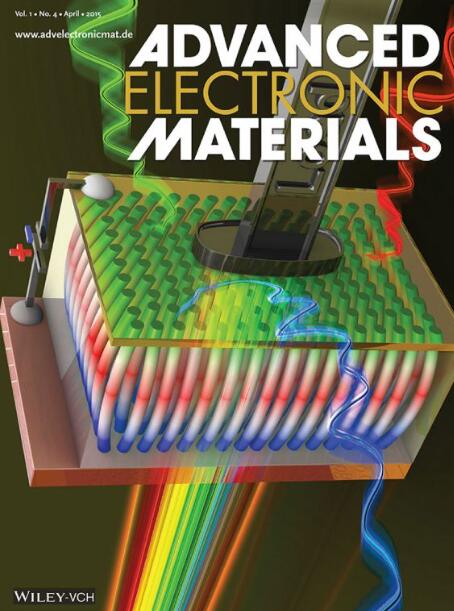Fabrication and Characterization of Ga2O3 FinFETs on Patterned Silicon Substrate
IF 5.3
2区 材料科学
Q2 MATERIALS SCIENCE, MULTIDISCIPLINARY
引用次数: 0
Abstract
This study investigates the performance of thin film Ga2O3-based fin field-effect transistors (FinFETs) built on patterned silicon substrates. The Ga2O3 thin film is deposited using trimethylgallium (TMGa) ALD processes. Three devices are fabricated: one utilizing as-deposited thin film materials, another subjected to post-deposition annealing at 450°C, and a third annealed at 900°C. The electrical, optical, and material properties of the thin films and transistor devices are evaluated using a range of complementary characterization techniques, whilst the effects of post-deposition annealing at moderate (450°C) and higher temperature (900°C) are also investigated. The as-deposited device exhibited an Ion/Ioff ratio of 8.8 × 106, an Ion density of 0.062 µA.µm−2, a maximum charge carrier mobility of 3.2 cm2.V−1s−1, a threshold voltage (Vth) of 7.9 V, a sub-threshold swing (SS) of 590 mV.dec−1, and a breakdown voltage (BVDSS) of 40 V. After annealing in N2 atmosphere, the device annealed at 450°C displayed significant improvements, with an Ion/Ioff ratio of 8.3 × 107, Ion density of 0.14 µA.µm−2, a maximum charge carrier mobility of 8.5 cm2.V−1s−1, Vth of 8.5 V, SS of 475 mV.dec−1, and a remarkable BVDSS exceeding 200 V. In contrast, the 900°C annealed sample exhibited a decrease in performance, with an Ion/Ioff ratio of 1.2 × 107, Ion density of 0.023 µA.µm−2, mobility dropping to 1.4 cm2.V−1s−1, Vth of 9.2 V, and SS of 510 mV.dec−1, although it maintained a breakdown voltage above 200 V. The surface morphology and materials compositions of the fabricated devices are further analyzed via a combination of scanning electron and transmission electron microscopy techniques. The obtained results confirmed a significant material transition from amorphous phase in as-deposited films into polycrystalline morphologies with noticeable grain boundaries for samples with thermal annealing.

图像化硅衬底上Ga2O3 finfet的制备与表征
本文研究了基于图像化硅衬底的ga2o3薄膜翅片场效应晶体管(finfet)的性能。采用三甲基镓(TMGa) ALD工艺沉积Ga2O3薄膜。制造了三个器件:一个利用沉积薄膜材料,另一个在450°C下进行沉积后退火,第三个在900°C下退火。使用一系列互补的表征技术评估薄膜和晶体管器件的电学、光学和材料特性,同时还研究了在中等(450°C)和较高温度(900°C)下沉积后退火的影响。该器件的离子/脱落比为8.8 × 106,离子密度为0.062µA。µm−2,最大载流子迁移率为3.2 cm2。V−1s−1,阈值电压(Vth)为7.9 V,亚阈值摆幅(SS)为590 mV.dec−1,击穿电压(BVDSS)为40 V。在N2气氛中退火后,器件在450°C退火后表现出明显的改进,离子/脱落比为8.3 × 107,离子密度为0.14µA。µm−2,最大载流子迁移率为8.5 cm2。V−1s−1,Vth为8.5 V, SS为475 mV.dec−1,BVDSS超过200 V。相比之下,900℃退火后的样品性能有所下降,离子/脱落比为1.2 × 107,离子密度为0.023µa。µm−2,迁移率降至1.4 cm2。V−1s−1,Vth为9.2 V, SS为510 mV.dec−1,但击穿电压保持在200v以上。通过扫描电子和透射电子显微镜技术的结合,进一步分析了所制备器件的表面形貌和材料成分。得到的结果证实了在热处理后的样品中,材料从沉积膜中的非晶相转变为具有明显晶界的多晶形态。
本文章由计算机程序翻译,如有差异,请以英文原文为准。
求助全文
约1分钟内获得全文
求助全文
来源期刊

Advanced Electronic Materials
NANOSCIENCE & NANOTECHNOLOGYMATERIALS SCIE-MATERIALS SCIENCE, MULTIDISCIPLINARY
CiteScore
11.00
自引率
3.20%
发文量
433
期刊介绍:
Advanced Electronic Materials is an interdisciplinary forum for peer-reviewed, high-quality, high-impact research in the fields of materials science, physics, and engineering of electronic and magnetic materials. It includes research on physics and physical properties of electronic and magnetic materials, spintronics, electronics, device physics and engineering, micro- and nano-electromechanical systems, and organic electronics, in addition to fundamental research.
 求助内容:
求助内容: 应助结果提醒方式:
应助结果提醒方式:


